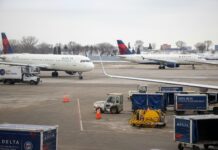Brightline West Project Progresses Towards Construction Kickoff
Exciting developments are on the horizon as Brightline West gears up to commence construction on its groundbreaking 218-mile high-speed rail line connecting Las Vegas and Southern California. Eric Scheetz, the dedicated Nevada Department of Transportation senior project manager overseeing this transformative project, recently shared that the team is poised to break ground within the coming months, marking the beginning of intensive work on this ambitious venture.
Awaiting the Green Light
Before the construction can officially commence, NDOT eagerly anticipates Brightline West’s attainment of the necessary financing for the monumental $12 billion initiative, along with the completion of essential design and contractor agreements. Notably, a significant milestone achieved last year was the successful acquisition of a $3 billion grant bestowed upon NDOT and Brightline by the Federal Railroad Administration, a pivotal step that Scheetz described as a monumental victory for Nevada.
Funding the Future
With the lion’s share of the project’s $9 billion budget falling under Brightline’s purview, the private entity is diligently exploring various avenues to secure the requisite funds. Leveraging $5.5 billion in private activity bonding authority, Brightline is in the process of embarking on a road show to secure an additional $2.5 billion in private activity bonds, with the remaining costs expected to be covered by a privately financed bank loan. The fluidity of these financial negotiations underscores the dynamic nature of the project, with Scheetz emphasizing the critical importance of these impending developments.
Strategic Planning for Success
As the project unfolds, NDOT and Brightline are preparing for a comprehensive four-year timeline from the onset of construction, with an emphasis on segment-based progress to ensure efficient completion. Scheetz highlighted the meticulous planning involved, with an initial focus on heavy civil work preceding the installation of rail systems in subsequent years. The subdivision of the project into nine distinct segments underscores the strategic approach adopted to optimize efficiency and expertise in each phase of construction.
Mitigating Risks for a Smooth Journey
In the realm of project management, NDOT has crafted a subrecipient agreement with Brightline to delegate the responsibility of project liability, ensuring accountability and adherence to agreed-upon benchmarks. With risk management standing as a paramount concern, Scheetz emphasized the importance of maintaining rigorous oversight to uphold project integrity and guarantee a successful outcome. The deployment of an independent engineer to monitor construction progress on the California side further bolsters the project’s commitment to quality and precision.
Paving the Way for Eager Travelers
Anticipating a robust influx of travelers, the envisioned high-speed rail line is projected to accommodate 37 daily trains shuttling passengers between Southern Nevada and Southern California. With a keen eye on enhancing accessibility, the planned Rancho Cucamonga station presents a compelling proposition for commuters, featuring a sizable 3,700-space parking structure for convenient access. Moreover, the station’s strategic connection to California’s Metrolink passenger rail network promises seamless travel options for commuters traversing between downtown L.A. and the bustling Rancho Cucamonga hub.
Looking Towards the Future
In the whirlwind of activity surrounding the Brightline West project, the impending commencement of construction heralds a new chapter in the evolution of transportation infrastructure between Las Vegas and Southern California. As the intricate web of financing, design, and construction continues to unfold, the collaborative efforts of NDOT, Brightline, and various stakeholders underscore a shared commitment to excellence and innovation. With each milestone, the promise of enhanced connectivity, convenience, and efficiency beckons, heralding a future where high-speed rail serves as a transformative force for regional travel and economic vitality.











